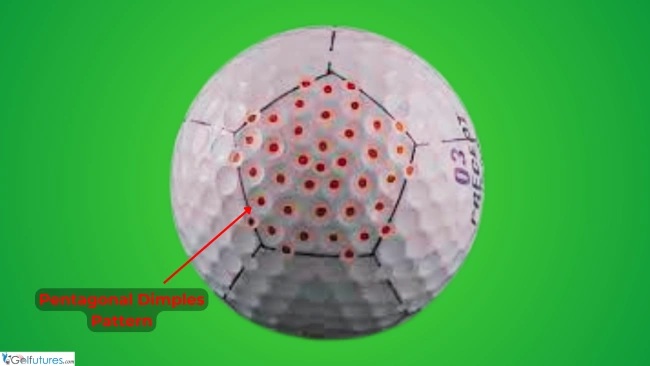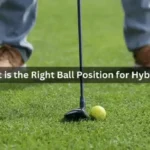Ever think about a golf ball’s design? It looks simple, but it’s full of tiny details called dimples. But how many are on a standard golf ball? The answer might amaze you and show you how golf balls work.
How Many Dimples Are on a Golf Ball?

Most golf balls have 300 to 500 dimples. This range helps with distance, stability, and control. It’s not a rule, but it’s the standard across brands after lots of research and testing.
Each brand designs dimples to meet specific performance goals. They balance distance, aerodynamics, and feel.
Popular Golf Ball Brands and Their Dimple Counts

Here are dimple counts for well-known golf balls. They show how manufacturers design within the typical range:
| Brand | Model | Dimple Count |
| Titleist | Pro V1 | 352 |
| Callaway | Chrome Soft | 332 |
| TaylorMade | TP5 | 322 |
| Bridgestone | Tour B XS | 330 |
| Srixon | Z-Star | 338 |
Even though dimple counts are close, small changes can make a big difference. They affect lift, drag, and spin rates. This caters to different swing types and playing styles.
Why Dimple Counts Matter
The precise number and design of dimples are critical because they affect how the air flows around the ball during flight. Dimples reduce air resistance and create lift, helping the ball travel farther and straighter. Each brand continually refines its dimple technology to meet the high-performance demands of golfers at all levels.
By maintaining dimple counts within the optimal range, manufacturers ensure their golf balls meet competitive standards while offering consistency and reliability in performance.
Effect of Dimples on Golf Ball Distance
Dimples on a golf ball are key for reaching the farthest distance. They affect both carry distance and roll distance. Knowing how dimples influence trajectory and backspin helps golfers pick the best ball for their game.
Dimples and Carry Distance

The carry distance is how far a ball flies before it lands. Dimples reduce air resistance, making the ball go farther. The depth and pattern of dimples can change the ball’s flight path, leading to a longer carry distance.
Dimples and Roll Distance

After landing, the roll distance affects the ball’s total distance. Dimples also impact how far the ball rolls. Balls with shallower dimples tend to stop faster on the greens due to more backspin. Balls with deeper dimples roll more after landing, adding to their total distance.
Golf ball makers design dimples to boost distance for different swings and conditions. Some aim for more carry distance for slower swings. Others balance carry and roll for faster swings. Golfers can improve their distance by choosing a ball that matches their swing.
Different Dimple Patterns and Their Impact on Performance
Golf ball manufacturers use various dimple patterns to optimize the ball’s aerodynamics. This influences its flight, spin, and overall performance.
Each pattern affects key aspects such as distance, trajectory, and control. They offer unique benefits tailored to different playing styles. Below are some notable dimple patterns and their impacts:
Spherical Dimples Pattern

- Traditional round dimples evenly distributed across the ball’s surface.
- Impact on Performance: Provides a balanced trajectory and moderate spin, making it versatile for all-around play.
Hexagonal Dimples Pattern

- Hexagon-shaped dimples arranged uniformly.
- Impact on Performance: Reduces drag and boosts lift, resulting in a higher trajectory and increased distance.
Tetrahedral Dimples Pattern

- Triangular dimples organized in a tetrahedral layout.
- Impact on Performance: Creates a lower trajectory with higher spin and better control for precise shots.
Pentagonal Dimples Pattern

- Five-sided dimples designed to enhance airflow efficiency.
- Impact on Performance: Improves overall airflow, delivering a unique trajectory that combines elements of distance and control.
The Science Behind Dimple Patterns

Dimple patterns on a golf ball are not just for looks. They are key to the ball’s aerodynamics and how well it performs. This design affects the ball’s path, distance, and stability in the air.
Aerodynamics and Golf Ball Flight
Dimples are crucial in how a golf ball moves through the air. When hit, the ball faces lift and drag. Lift keeps it flying, while drag slows it down. Dimples create a thin air layer that sticks to the ball, cutting down drag and letting it fly farther.
How Dimple Patterns Create Lift
Dimples also help with backspin, which adds lift. The spin changes airflow, creating pressure differences. This pushes the ball up, keeping its flight steady and controlled. The precise design of dimple patterns balances drag and lift for better distance and accuracy.
Understanding the science behind dimple patterns can help you see how a ball’s design affects your game. With this knowledge, you can choose the right ball for your playing style and the course.
What Are the USGA and R&A Rules for Golf Ball Dimples?
The United States Golf Association (USGA) and the Royal and Ancient Golf Club of St Andrews (R&A) establish strict guidelines for golf balls used in professional play. These regulations ensure fairness and consistency in the game by standardizing the design and performance of golf balls.
The USGA and R&A set strict rules for golf balls in professional play. These rules make the game fair and consistent by standardizing ball design and performance.
The USGA and R&A set strict rules for golf balls in professional play. These rules make the game fair and consistent by standardizing ball design and performance.
The rules for golf ball design include the following:
1. Golf Ball Weight:
- The maximum weight for a golf ball is 1.62 ounces (45.93 grams).
2. Golf Ball Diameter:
- A golf ball must be at least 1.68 inches (42.67 mm) in diameter.
3. Dimple Symmetry:
- The dimple pattern must be symmetrical for consistent performance.
- Asymmetrical designs or features that might provide an unfair advantage are not allowed.
4. Dimple Depth and Size:
- While no specific limit is stated for dimple depth or diameter, manufacturers typically adhere to depths between 0.01 and 0.02 inches and diameters ranging from 0.12 to 0.16 inches to meet aerodynamic and performance expectations.
FAQSs
Q: Why do golf balls have dimples?
A: Golf balls have dimples to improve air movement. The dimples create a thin air layer that sticks to the ball. This reduces drag and lets the ball go further.
Q: What happens if a golf ball has no dimples?
A: A smooth golf ball lacks the aerodynamic properties needed for optimal performance. It would experience higher air resistance, leading to a shorter and less consistent flight path.
Q: Are all golf balls designed with the same number of dimples?
A: No, golf balls have varying dimple counts for different designs and purposes. Typical counts range from 300 to 500 dimples, with patterns and depths tailored for different levels of spin, control, and distance.
Q: Do the size and shape of dimples matter?
A: Yes, the size, shape, and arrangement of dimples directly affect the ball’s lift and spin characteristics. Larger or deeper dimples often create more spin, while smaller ones may focus on distance.
Q: Why do some golf balls have different dimple patterns?
A: Golf ball makers create unique dimple patterns for certain benefits. They want to improve control, spin, or how far the ball goes. Some use hexagons, while others go for circles or unique shapes. It all depends on who they think will use the ball.







